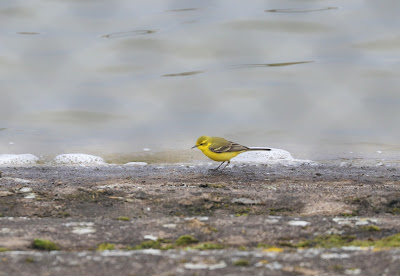Last Saturday morning (07/04), I did a bit of patching with Gareth, something we hadn't done for some time. We saw all 3 hirundines in small numbers, including our first patch House Martins of the year, our first Willow Warbler of 2018, a pair of LRP and a few Blackcap.

With Ring Ouzels turning up in quite a number of places throughout the country, I decided to then drive to Newnham Hill and the adjacent Borough Hill, on the edge of Daventry - two of the better Northants sites for Rouzels in recent years. My instinct appeared to be in good order, as while driving over there my phone pinged to say there was a probable Black Redstart on Newnham Hill!
On arrival Stuart, a Northants birder was still there and his photos confirmed that it was indeed a female-type Black Redstart. It had been flushed by a local dog walker, so having had an unsuccessful look for it, I decided to carry on to Borough Hill, knowing that the BBC compound was an even higher and potentially more attractive proposition for a Black Red.
As it turned out, a 2 and a half hour yomp around the site produced little variety. A confiding male Wheatear was still very enjoyable. Other vaguely notable birds included a Redpoll over west, 2 Fieldfare south and a single foraging Willow Warbler.



I did also get some cracking views of a Weasel popping up out of rabbit holes by the gorse on the south side.


Heading for home, it was certainly worth having another look for the Black Redstart on Newnham Hill. Luckily, scanning the fence line down from the gate, produced what I was looking for. I set the scope up and enjoyed my first Northants Black Red for quite a few years.

The rest of this week has been all about the Grimsbury Res patch, visiting regularly throughout the week, in between work commitments.
The gloomy conditions made it a week to remember, bringing down a succession of quality birds. First up was a drake Common Scoter which I found on the morning of Monday (09/04). It stayed for the entire day and was my second record for the patch, following on from the four birds back in the autumn.

During some of the murkiest conditions of the week, an adult Kittiwake then loomed into view on the morning of Wednesday (11/04). It appeared high-ish from the west at 07:40am. Unfortunately it kept on going to the east and was soon lost to view after less than a minute. This is now the FOURTH year in a row I have seen Kittiwake at Grimbo which I find pretty remarkable for such a humble little patch!
Then there was the cherry on the cake! I had to take my car in for repair on the morning of Thursday (12/04), however I still made myself half an hour to do a relatively swift circuit of the patch, knowing that the conditions were conducive for something dropping in.
Walking up the west side of the reservoir I could see a male Tufted Duck at the far end, together with a brownish bird that I presumed was a female. It wasn't until I got right up to the northern end that I realised the brownish bird was not a female Tufted Duck at all, but a sleeping summer-plumaged Black Necked Grebe. WOW! I WhatsApped all who would want to know locally and then watched the bird for some 15 minutes, eventually seeing it wake up and then let out a few unexpected calls...fantastic! Gareth and I had said several times that it was about time the reservoir produced a rare Grebe or Diver and so it was nice for this to be realised!



There was a pretty reasonable supporting cast too, including a fly through Redshank, steady numbers of all three hirundines, a couple of Yellow Wagtail, White Wagtail, our first Common Sandpipers, up to 4 Willow Warbler, a pair of LRP, numerous Blackcap & Chiffchaff, at least 2 regular Peregrines, drake Shoveler and up to 3 Lesser Redpoll.










No comments:
Post a Comment